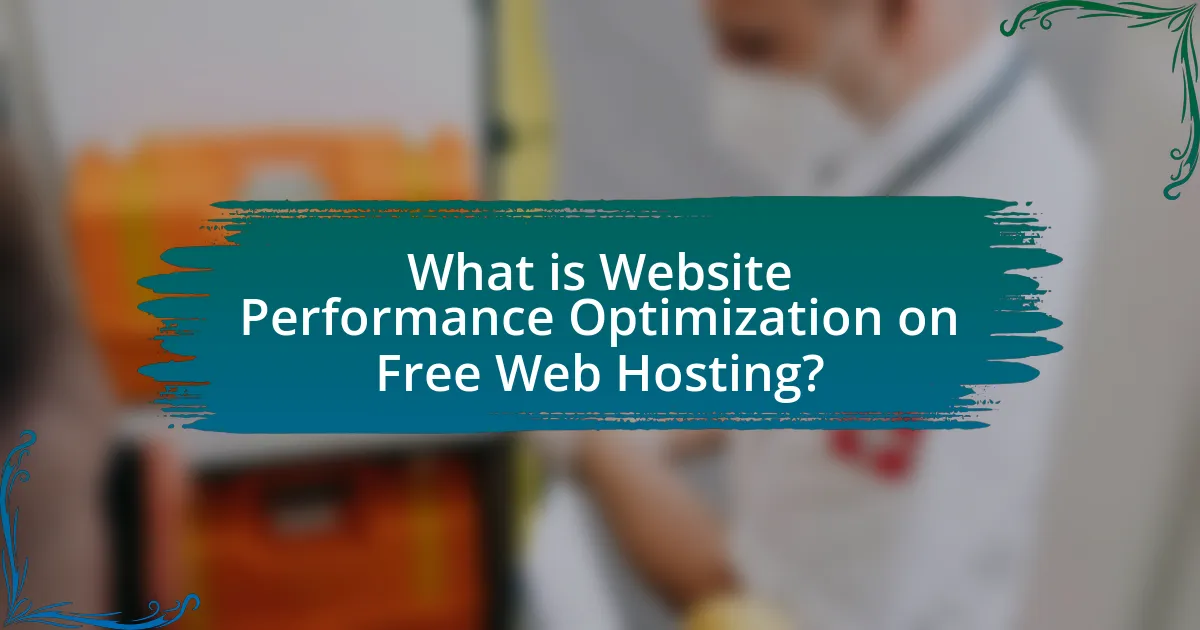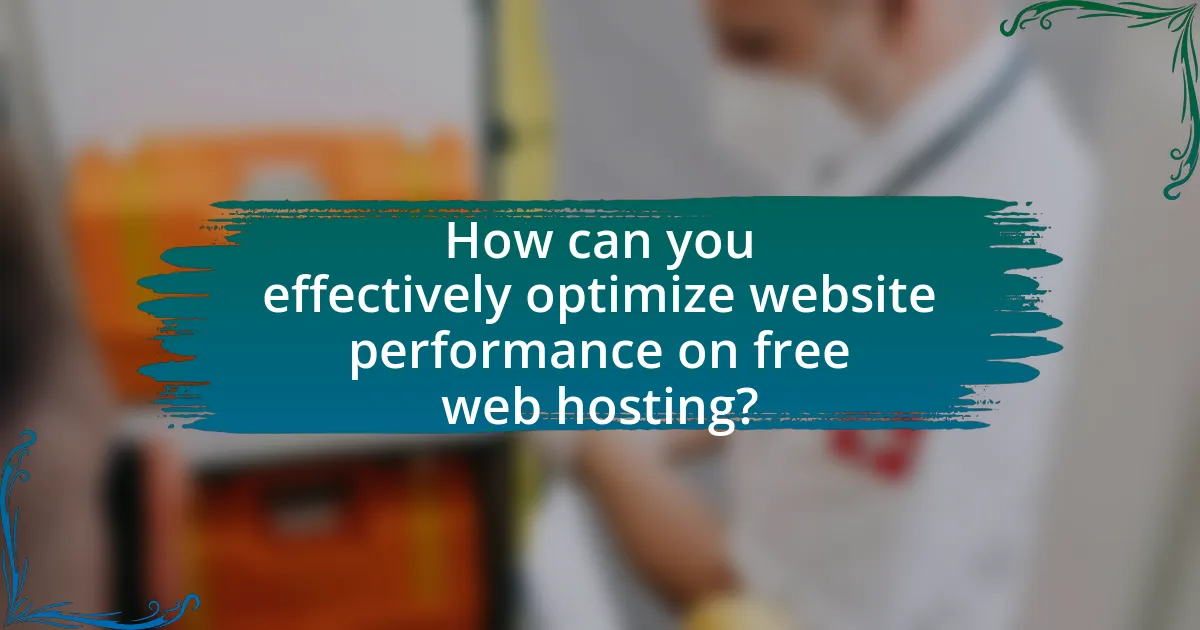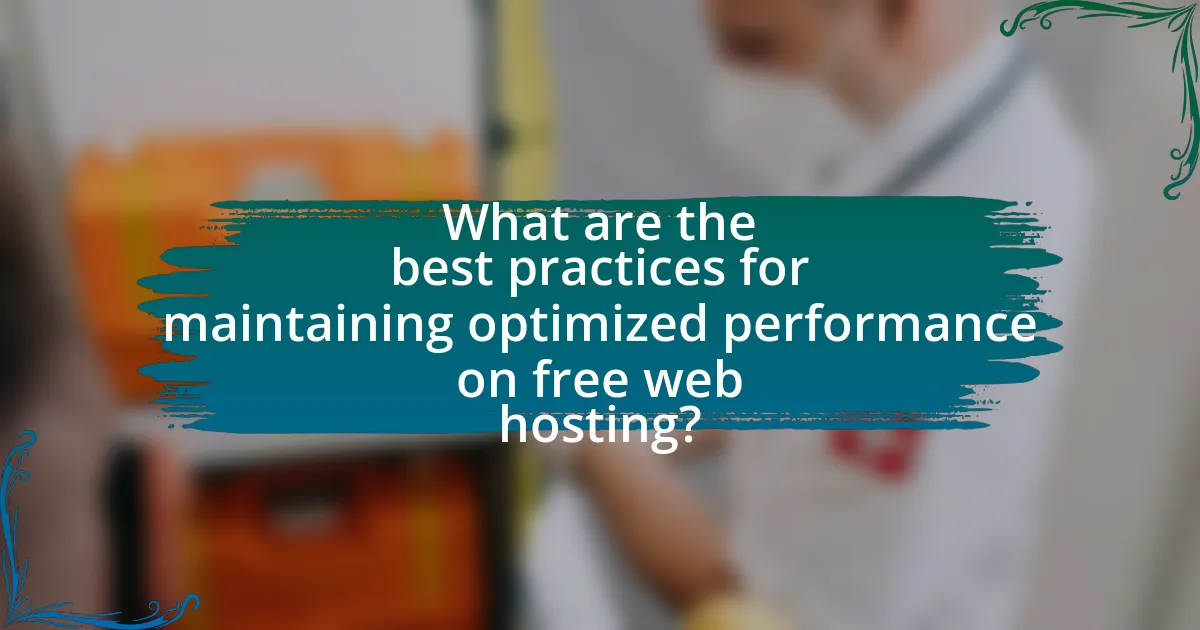Website performance optimization on free web hosting involves enhancing the speed, responsiveness, and efficiency of websites hosted on platforms that offer limited resources. This article outlines the impact of website performance on user experience, emphasizing the importance of fast loading times for retention and conversion rates. It discusses key metrics for measuring performance, common challenges faced with free hosting services, and effective optimization strategies, including image optimization and caching techniques. Additionally, it highlights the role of performance testing tools and best practices for maintaining optimal website performance, ensuring that users can achieve a responsive and efficient online presence despite the constraints of free hosting options.

What is Website Performance Optimization on Free Web Hosting?
Website performance optimization on free web hosting refers to the process of enhancing the speed, responsiveness, and overall efficiency of a website hosted on a free hosting platform. This optimization is crucial because free web hosting often comes with limitations such as slower server response times, restricted bandwidth, and less reliable uptime compared to paid services. Techniques for optimization include minimizing file sizes, leveraging browser caching, optimizing images, and using content delivery networks (CDNs) to improve load times. Studies show that a one-second delay in page load time can lead to a 7% reduction in conversions, highlighting the importance of performance optimization even on free hosting platforms.
How does website performance impact user experience?
Website performance significantly impacts user experience by influencing loading times, interactivity, and overall satisfaction. Faster loading times lead to lower bounce rates; for instance, a study by Google found that a one-second delay in mobile page load time can decrease conversions by up to 20%. Additionally, improved performance enhances user engagement, as users are more likely to interact with a site that responds quickly. Research from Akamai indicates that 47% of consumers expect a web page to load in two seconds or less, highlighting the critical relationship between performance and user retention.
What metrics are used to measure website performance?
Key metrics used to measure website performance include page load time, time to first byte (TTFB), bounce rate, and conversion rate. Page load time indicates how quickly a webpage loads, with optimal performance being under three seconds, as studies show that a delay of just one second can reduce customer satisfaction by 16%. Time to first byte measures the responsiveness of a web server, with lower values indicating better performance. Bounce rate reflects the percentage of visitors who leave after viewing only one page, with lower rates suggesting higher engagement. Conversion rate measures the percentage of visitors who complete a desired action, such as making a purchase, and is critical for assessing the effectiveness of a website in achieving its goals.
Why is website speed crucial for retention and conversion?
Website speed is crucial for retention and conversion because faster loading times directly enhance user experience, leading to higher engagement rates. Research indicates that a one-second delay in page load time can result in a 7% reduction in conversions, as users are more likely to abandon slow-loading sites. Additionally, Google reports that 53% of mobile users will leave a page that takes longer than three seconds to load, emphasizing the importance of speed in retaining visitors. Therefore, optimizing website speed is essential for maximizing both user retention and conversion rates.
What challenges do free web hosting services present for optimization?
Free web hosting services present significant challenges for optimization due to limitations in resources, performance, and control. These services often impose bandwidth restrictions, which can lead to slow loading times and affect user experience negatively. Additionally, free hosting typically offers limited storage space, restricting the amount of content and media that can be hosted, thereby hindering site performance.
Moreover, free web hosting often lacks advanced features such as caching, content delivery networks (CDNs), and SSL certificates, which are essential for optimizing website speed and security. The absence of these features can result in lower search engine rankings, as site speed is a critical factor in SEO algorithms. Furthermore, free hosting services may display ads on user sites, detracting from the user experience and potentially driving visitors away.
In summary, the constraints of free web hosting services, including limited resources, lack of essential optimization features, and potential ad placements, create substantial barriers to achieving optimal website performance.
How do resource limitations affect website performance?
Resource limitations significantly degrade website performance by restricting the availability of essential computing resources such as CPU, memory, and bandwidth. When a website operates under constrained resources, it experiences slower load times, increased latency, and potential downtime, which can lead to a poor user experience. For instance, a study by Google found that a one-second delay in mobile page load time can reduce conversions by up to 20%. Additionally, limited bandwidth can cause bottlenecks during high traffic periods, further exacerbating performance issues. These factors collectively hinder a website’s ability to serve content efficiently, ultimately affecting user retention and search engine rankings.
What common issues arise with free web hosting providers?
Common issues that arise with free web hosting providers include limited bandwidth, lack of customer support, and frequent downtime. Limited bandwidth restricts the amount of data that can be transferred, which can lead to slow loading times and potential site crashes during high traffic periods. The absence of reliable customer support means that users may struggle to resolve technical issues promptly, impacting website performance. Additionally, frequent downtime can occur due to server overload or maintenance, which can negatively affect user experience and search engine rankings. These factors collectively hinder the overall effectiveness of a website hosted on a free platform.

How can you effectively optimize website performance on free web hosting?
To effectively optimize website performance on free web hosting, utilize techniques such as minimizing file sizes, leveraging browser caching, and optimizing images. Minimizing file sizes through compression reduces load times, while browser caching allows frequently accessed resources to be stored locally, decreasing server requests. Optimizing images by using appropriate formats and resolutions ensures faster loading without sacrificing quality. According to Google, optimizing images can reduce page load time by up to 80%, significantly enhancing user experience and engagement.
What strategies can be employed for optimization?
To optimize website performance on free web hosting, strategies include minimizing HTTP requests, leveraging browser caching, and optimizing images. Minimizing HTTP requests reduces the number of elements that need to load, which can significantly speed up page load times. For instance, combining CSS and JavaScript files can decrease the number of requests. Leveraging browser caching allows frequently accessed resources to be stored locally on users’ devices, reducing load times for repeat visitors. According to Google, effective caching can improve load times by up to 80%. Optimizing images by compressing them without losing quality can also enhance performance; tools like TinyPNG can reduce image sizes significantly, leading to faster loading times. These strategies collectively contribute to a more efficient and responsive website experience.
How does image optimization contribute to performance?
Image optimization significantly enhances website performance by reducing file sizes without compromising quality. Smaller image files lead to faster loading times, which is crucial for user experience and search engine rankings. According to Google, a one-second delay in mobile load times can lead to a 20% decrease in conversions. Additionally, optimized images consume less bandwidth, which is particularly beneficial for websites hosted on free platforms with limited resources. This efficiency not only improves page speed but also decreases server load, allowing for better overall performance.
What role does caching play in website speed?
Caching significantly enhances website speed by storing frequently accessed data temporarily, allowing for quicker retrieval. When a user visits a website, caching reduces the need to fetch data from the server repeatedly, which can be time-consuming. For instance, according to Google, effective caching can improve page load times by up to 80%, leading to a better user experience and lower bounce rates. This efficiency is crucial for optimizing website performance, especially on free web hosting platforms where resources may be limited.
What tools can assist in optimizing website performance?
Tools that can assist in optimizing website performance include Google PageSpeed Insights, GTmetrix, and WebPageTest. Google PageSpeed Insights analyzes the content of a web page and provides suggestions to improve speed, with metrics such as First Contentful Paint and Time to Interactive. GTmetrix combines Google Lighthouse and WebPageTest to offer insights on page load times and performance scores, allowing users to identify bottlenecks. WebPageTest allows for detailed performance testing from multiple locations and browsers, providing waterfall charts that illustrate how resources load over time. These tools are widely recognized in the industry for their effectiveness in identifying performance issues and suggesting actionable improvements.
How can performance testing tools help identify issues?
Performance testing tools help identify issues by simulating user interactions and measuring system performance under various conditions. These tools provide metrics such as response times, throughput, and resource utilization, which highlight bottlenecks and performance degradation. For instance, tools like Apache JMeter and LoadRunner can reveal how a website behaves under heavy traffic, allowing developers to pinpoint specific areas that require optimization, such as slow database queries or inadequate server resources. By analyzing these metrics, teams can make informed decisions to enhance website performance, ensuring a better user experience on free web hosting platforms.
What are the best plugins for performance optimization?
The best plugins for performance optimization include WP Rocket, W3 Total Cache, and Autoptimize. WP Rocket is a premium caching plugin that significantly improves loading times by implementing caching, minification, and lazy loading. W3 Total Cache is a free plugin that enhances site performance through caching and content delivery network (CDN) integration, which can lead to a 10x improvement in performance according to user reports. Autoptimize focuses on optimizing CSS, JavaScript, and HTML, which can reduce page size and improve load times. These plugins are widely recognized for their effectiveness in enhancing website performance, especially on free web hosting platforms.

What are the best practices for maintaining optimized performance on free web hosting?
To maintain optimized performance on free web hosting, users should implement several best practices. First, minimizing file sizes through compression techniques, such as Gzip, can significantly reduce load times. Studies show that reducing file sizes can improve page load speed by up to 70%. Second, utilizing a content delivery network (CDN) can enhance performance by distributing content across multiple servers, thereby decreasing latency. Research indicates that CDNs can improve load times by 50% or more. Third, optimizing images by using appropriate formats and resolutions can further enhance website speed, as unoptimized images can account for over 60% of a webpage’s total weight. Fourth, limiting the use of plugins and scripts can prevent slowdowns, as excessive plugins can lead to increased server requests and longer load times. Lastly, regularly monitoring website performance using tools like Google PageSpeed Insights can help identify areas for improvement, ensuring that the site remains responsive and efficient.
How can regular maintenance improve website performance?
Regular maintenance significantly improves website performance by ensuring optimal functionality and speed. This process includes updating software, optimizing databases, and checking for broken links, which collectively enhance loading times and user experience. For instance, a study by Google found that a one-second delay in loading time can lead to a 20% decrease in conversions, highlighting the importance of maintaining website speed. Additionally, regular maintenance helps identify and fix security vulnerabilities, which can prevent downtime and maintain user trust. Overall, consistent upkeep leads to a more efficient, reliable, and user-friendly website.
What routine checks should be performed to ensure optimal performance?
Routine checks to ensure optimal performance of a website on free web hosting include monitoring website uptime, checking page load speed, reviewing server response times, and analyzing website traffic. Uptime monitoring ensures that the website is accessible to users, while page load speed affects user experience and search engine rankings; studies show that a one-second delay can reduce conversions by 7%. Regularly reviewing server response times helps identify potential bottlenecks, and analyzing website traffic provides insights into user behavior and resource usage, allowing for informed adjustments. These checks collectively contribute to maintaining a high-performing website.
How can updates and backups affect website speed?
Updates and backups can significantly affect website speed by consuming server resources and increasing load times. When a website undergoes updates, such as software or plugin installations, it may temporarily slow down due to the additional processing required. For instance, WordPress updates can lead to increased database queries, which can slow down page loading times. Similarly, backups, especially if performed during peak traffic hours, can strain server resources, leading to slower response times. A study by Google indicates that a one-second delay in loading time can lead to a 20% decrease in conversions, highlighting the importance of managing updates and backups effectively to maintain optimal website speed.
What troubleshooting steps can be taken if performance issues arise?
To address performance issues on a website hosted for free, first, check the server response time using tools like GTmetrix or Pingdom. These tools provide insights into how quickly the server responds to requests, which is crucial for performance. Next, optimize images by compressing them to reduce load times, as large images can significantly slow down a website. Additionally, minimize HTTP requests by combining CSS and JavaScript files, which decreases the number of requests made to the server.
Furthermore, enable browser caching to store frequently accessed resources locally on users’ devices, reducing load times for repeat visitors. Lastly, review the website’s code for inefficiencies, such as excessive plugins or unoptimized scripts, which can hinder performance. These steps are validated by performance optimization best practices, which emphasize the importance of server response time, image optimization, and efficient coding in enhancing website speed.
How can you identify the source of slow loading times?
To identify the source of slow loading times, utilize performance monitoring tools such as Google PageSpeed Insights, GTmetrix, or WebPageTest. These tools analyze various factors affecting load speed, including server response time, file sizes, and the number of requests made. For instance, Google PageSpeed Insights provides specific metrics like Time to First Byte (TTFB) and suggests optimizations based on real user data. By examining these metrics, you can pinpoint whether the issue lies with server performance, large images, unoptimized scripts, or excessive HTTP requests, allowing for targeted improvements to enhance website speed.
What are common fixes for performance-related problems?
Common fixes for performance-related problems include optimizing images, leveraging browser caching, and minimizing HTTP requests. Optimizing images reduces file sizes without sacrificing quality, which can significantly decrease load times; studies show that image optimization can improve page speed by up to 80%. Leveraging browser caching allows frequently accessed resources to be stored locally on a user’s device, reducing server load and improving response times. Minimizing HTTP requests by combining files, such as CSS and JavaScript, can also enhance performance, as each request adds latency; research indicates that reducing requests can lead to a 50% faster load time.
What are the key takeaways for optimizing website performance on free web hosting?
To optimize website performance on free web hosting, focus on minimizing resource usage and enhancing loading speed. Key strategies include using lightweight themes and plugins, optimizing images for web use, and leveraging browser caching to reduce load times. Additionally, employing Content Delivery Networks (CDNs) can distribute content efficiently, improving access speed for users across different locations. Regularly monitoring website performance through tools like Google PageSpeed Insights can provide actionable insights for further optimization. These practices collectively contribute to a more efficient and responsive website experience, even on limited hosting resources.


